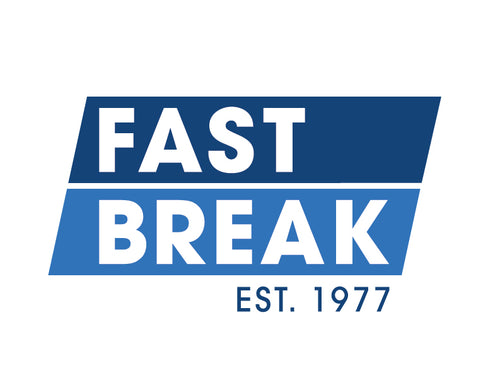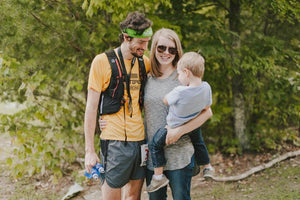In June 2015, Bellhops Vice President Nathan Sexton was standing in the startup’s new office space when he felt the world spinning and collapsed. He woke up a day later with a tube down his throat and the doctors diagnosis of a large brain tumor. He was told he may never walk or talk normal again.
This October, 2016, Nathan finished 11th at the Stump Jump 50k.
You might have read about Nathan in the Times Free Press, or watched a mini-documentary about running a half marathon with brain cancer. Nathan has continued to blow away all expectations from doctors about his condition. We invited him into the store to talk about his running journey.
When did you first get into running?
My first run in Strava was when I really started training for that first half marathon. Before then, I was a decent sprinter, like in high school. So it wasn't like I hadn't run. I had always enjoyed running. But I couldn't ever get past 3 to 5 miles without something hurting. I always went back to running as a way to clear my mind. It was always a part of my life, but I just never ran long distance. The most I'd ever run in my life was like 7 miles before then. So late November/December last year.
Why trail running versus road?
I've really taken to trail running because it puts you in the present. You always have to be focused, not stepping on rocks. In road running, you can look down at your watch for your pace every mile - and, at least for me, I'm so worried about pace. But on trails, you don't really have to think about that. You just kinda go with the trail. I love that about trail running.
What difficulties have you faced in running with a brain tumor?
The hardest part is creating a training schedule around the treatments. You never know how you're going to feel. I was planning on going running after my [last] treatment, but I felt kind of nauseous. With the treatment I'm going through, you just don't know how you're going to feel. You're body is responding in different ways each time. Sometimes I feel great and I don't have many side affects, but sometimes I wake up and have a pounding headache all day. So you just can’t run. It's kind of hard to have a set schedule of training. I have to work around how I feel. If I can't run there's not much else I can do. I mean I could do a bunch of sit-ups, but who wants to do those?
Tell us about the diet you’re on and how you fuel for races. You ran into some fueling issues at Stump Jump a few weeks ago. What are you learning from that?
Basically low carb, high fats. I fluctuate between 50-60 grams of net carbs, which is total carbs minus dietary fiber. Because dietary fiber passes through you and doesn't really affect blood insulin levels. I've done this for a year and a half now.
The whole concept behind the diet is that, the body, especially the brain, runs on glucose, but it also can run on ketones. So the healthy cells can take those ketones and transfer them into energy, but the tumor cells can’t. They have a deficient mitochondria, and the mitochondria is what converts everything to fuel. In essence, you're starving the tumor cells enabling to grow by giving it fat in the form of ketones.
Originally that's why I started doing this diet, then I started reading about the endurance aspect of it, and getting really into the weeds of that and finding out that you can really become fat-adapted. You only have 2,000 calories of glycogen tanks and even a lean athlete has 40,000 calories of fat, and if you can tap into that you can potentially run a 50 mile race without really ever fueling. But you couldn’t do it at the pace I want to do it at.
So I’ve been trying to figure out a good way to fuel. I kind of feel that my legs fill with lactic acid, which is a byproduct of carbohydrate break down. So when you're breaking down fat, you still get a little bit of that lactic acid, but it's not nearly as much. So on a race day, if I were to take in a GU, it's like my legs are not used to it and they immediately fill with lactic acid. So I've been playing around with stuff. [At Stump Jump], I drank water pretty much most of the time and fueled with Justin's Hazelnut Butter which didn't really work out. It didn't give me that energy I needed. But UCan is awesome. You don't have that spike, or I don't get that lactic acid feeling. It's a slow carbohydrate release.
How do you deal with the down and dark moments in your running, or times when you just want to quit?
I do get those moments, but I'm just happy to be able to run. After the initial surgery, the doctor was like, “The tumor is lined up against his fine motor skills and he may not be able to use the right side of his body. He's probably going to have a tough time talking, maybe the rest of his life. Maybe it'll just be for six months, but he's probably going to have some difficulties.” My parents came in, and the first thing I did was grab a cup of ice with my right hand and was like, "I'm so thirsty." My mom just broke down crying. I walked out of the Neuro ICU in three days.
I guess when I do have those moments, I try to remember to thank God that I'm even able to run. I try not to put too much pressure on myself- to be recognized in the running world. I just run just because I love it. I've grown to love it and it counteracts a lot of the side effects of where the brain tumor sits. A lot of patients that have this tumor, where mine is located, deal with depression. The medications that I'm on — the anti-seizure medications — can make you aggravated, and running helps so much in a lot of ways. The best drug you can get is to run. For anybody struggling with depression, I would encourage them to get out and run.
Who is your hero?
My wife. She is the strongest person that I've ever met. I try to put myself in her position. It's so much harder than in my position. Just because she has to think about life potentially without me. Even though, it's such a finite period of time in respect to eternal life, it's probably just a blink of an eye, you know it's gotta be incredibly hard on her. We've had some really tough conversations that have all been really good, just about, “I want you to be able to remarry,” and stuff like that. Where she's like, “I don't want to talk about that.” And I say, "I know, but I don't want you to feel guilty. I want you to be happy." I may be able to live 20 years, who knows. I know conversations like that are so hard for her to hear, and thinking about raising Jack without me. All the while, I'll be looking down from heaven and I'll be in the best spot ever.
What have your learned through this journey?
I've learned to trust so much in the Lord and what He's doing, and I know I have a greater purpose. I see that now. I was so messed up before this. I claimed to be a Christian but I wasn't outwardly, I was living a life that seemed to be pretty good. I was vice president of operations at a cool startup. Elizabeth was associate director at volunteer Children's Chambliss Center. But I wasn't loving God, I was mainly loving myself. And I wasn't making disciples. This is all in my book. People loved and respected me at Bellhops just because I was one of the first ones there. I tried to make a fun environment. But I didn’t set the right example. I was over 50 people and I feel like I created an example of work your ass off. I didn't leave much time for family. I look back, when I go back, I still see that. I see that example that I left behind.
You mentioned the book you just wrote, Dear Jack. What is it about?
It was written for Jack. And I thought it could help other parents avoid the pitfalls of work-life balance. Put a Christian emphasis on a child's life and raise them in a Christian environment.
When's the next race?
The North Face Endurance Challenge 50 Miler, and hopefully, depending on how I feel, I signed up for the Lookout Mountain 50 Miler. They're two weeks apart. Not much recovery time in there. I want to do two 50 milers in one month.
What are you nervous about the two 50 milers?
Honestly, nothing. I've come to realize that I just want to finish both of them. I don't really care what place. I'm not too worried about it. i just want to go and have fun and run in the Marin woods. With Stump Jump, I put a lot of pressure on myself to do it really well. And with these two 50 milers, I just want to have fun and not put any pressure on myself and unneeded stress. And really try to figure out nutrition wise what I need.
If you’d like to continue following along Nathan’s journey, follow him at http://brainhops.blogspot.com
Photography by H. Davis Photography

